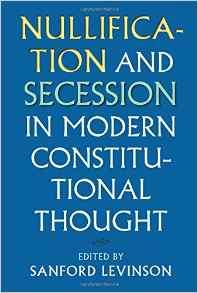The Volokh Conspiracy
Mostly law professors | Sometimes contrarian | Often libertarian | Always independent
Nullification and secession in America

In the aftermath of Donald Trump's unexpected victory in the presidential election, secession movements quickly arose in the liberal states of California and Oregon. Similar secessionist sentiment arose in some conservative states after President Obama won the 2012 election.
Polls consistently show that a substantial minority of Americans believe that their state has a right to secede, or even say that they actually want their state to leave the union. It is highly unlikely that any state actually will secede in the near future. Nonetheless, it is notable that so many Americans reject the dominant view among legal elites: that secession is unconstitutional and unthinkable.
Even more common than secessionist sentiment are various efforts by state and local governments to undercut enforcement of federal laws. Conservative states often work to prevent the enforcement of federal gun laws, while more liberal jurisdictions do the same with respect to immigration laws and laws banning marijuana.
Most of these efforts fall short of outright nullification—direct state interference with federal law enforcement. In my view, most of them are entirely legal. Nonetheless, in an era when the federal government depends on state cooperation to help enforce many of its laws, the denial of such cooperation often has effects similar to nullification. Without the help of state and local authorities, many federal laws often become almost impossible to enforce.
In an age of deep ideological polarization and growing partisan hatred, it is likely that both secessionist movements and state efforts at quasi-nullification will become even more common. Both right and left are increasingly fearful when the federal government is controlled by their opponents, and both are also increasingly willing to resist exercises of federal power that they see as unjust or even oppressive. That makes the recently published Nullification and Secession in Modern Constitutional Thought (edited by Sanford Levinson) timely and essential reading.
Levinson and the other contributors to this volume provide the most thorough and up to date analysis of nullification and secession in America currently available. While many people associate secessionism with the Confederacy and efforts to protect slavery, and nullification with state resistance to the civil rights movement, this book shows that both tactics were often advocated by political movements on both the right and the left. In the antebellum period for example, nullificationist tactics were adopted by both southerners seeking to protect slavery, and northerners trying to resist the federal Fugitive Slave Act. Like many political strategies, nullification and secession can be used to promote both good causes and evil ones.
Levinson's own contribution to the volume is a particularly thorough discussion of recent advocacy of nullification and secession in the United States. He shows that such movements have arisen on both sides of the political spectrum and some, at least, deserve to be taken seriously, even if many others are promoted by extremist cranks with little influence.
Excellent chapters by Ernest Young and Mark Graber usefully distinguish between outright nullification (open state disruption of US officials' efforts to enforce federal law) and various less extreme efforts to resist federal authority. The latter are actually far more common—and more effective -than the former. Jonathan Gienapp's essay provides an insightful analysis of James Madison's lifelong effort to strike a balance between empowering states to resist federal oppression and preventing them from undermining what he saw as legitimate federal authority. Madison's not entirely successful struggle with these issues remains surprisingly relevant today.
Ran Hirschl and Vicki Jackson assess American nullificationism and secessionism in comparative perspective. Hirschl's chapter is particularly interesting in that it shows, contrary to conventional wisdom, that nullification is not a uniquely American phenomenon. Similar movements have arisen elsewhere, including in Canada, Russia, and the European Union.
I certainly don't agree with all of the arguments advanced in this volume. For example, Jared Goldstein's chapter too readily conflates extreme violent nullificationists with more moderate advocates of similar ideas.
There are also a few issues that deserve greater attention than the contributors give them. Most notably, they only briefly mention secession movements that seek to break up not the nation, but merely an individual state. In recent years, secession movements seeking to carve out new states from existing ones have arisen in conservative counties in both California and Colorado.
The odds are stacked against such movements. But they are more likely to succeed than efforts by states to leave the union entirely. Indeed, efforts to break up a state actually have succeeded a few times in American history. The most notable examples are Maine's secession from Massachusetts and West Virginia's secession from Virginia during the Civil War.
Secession from a state also raises fewer moral and constitutional problems than secessionist attempts to form an entirely new nation. Obviously, it creates much less risk of civil war. In addition, residents of the new state would still enjoy the full protection of the US Constitution and federal statutory law. Unlike a new nation, a new state need not face the daunting prospect of providing for its own defense and trying to negotiate trade and migration agreements with the rump US. Breaking up some of our large states into smaller ones could both help frustrated political minorities, and increase Americans' ability to make political choices by "voting with their feet." Expanded opportunities for foot voting could enhance both political freedom and economic opportunity, especially for the poor and disadvantaged.
Despite a few such omissions, this book is an indispensable resource for anyone interested in nullification, secession, and state resistance to federal power more generally. Virtually all the chapters are readily accessible to laypeople as well as experts. The book could even make a great holiday gift for the federalism maven in your family.
To get the Volokh Conspiracy Daily e-mail, please sign up here.


Show Comments (0)